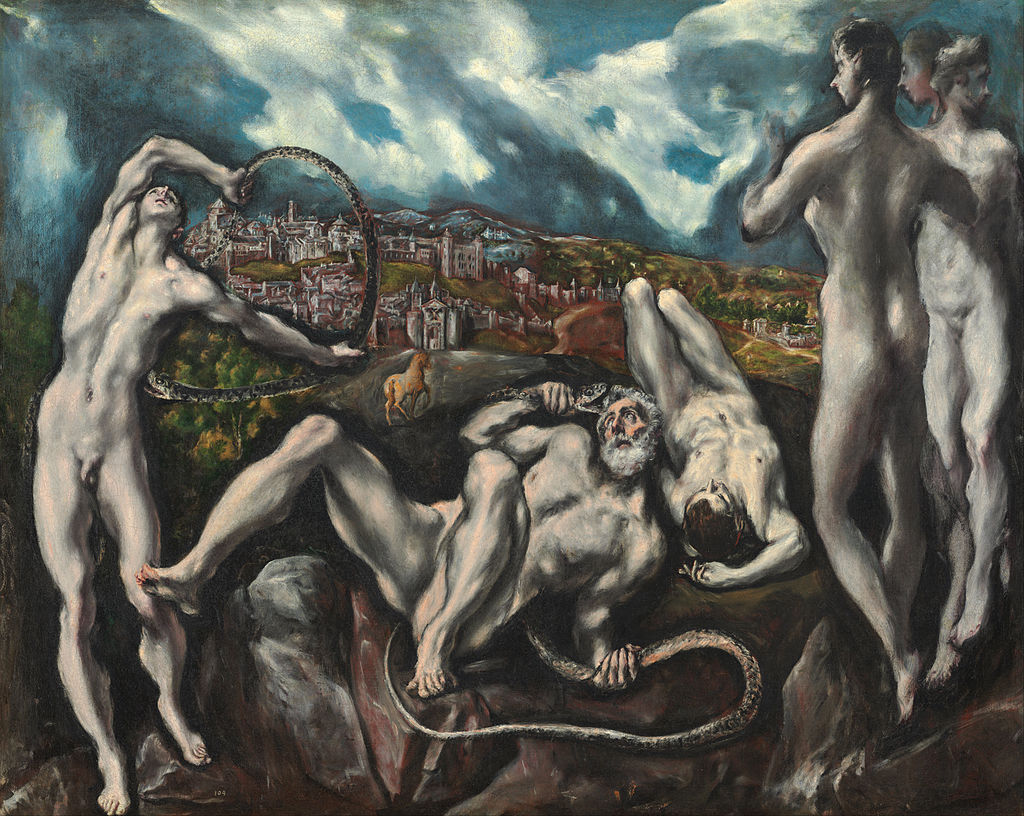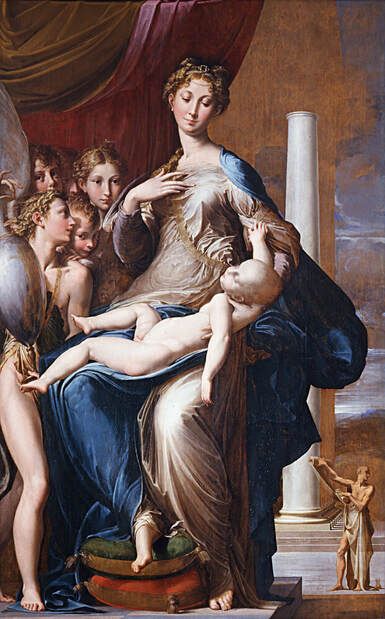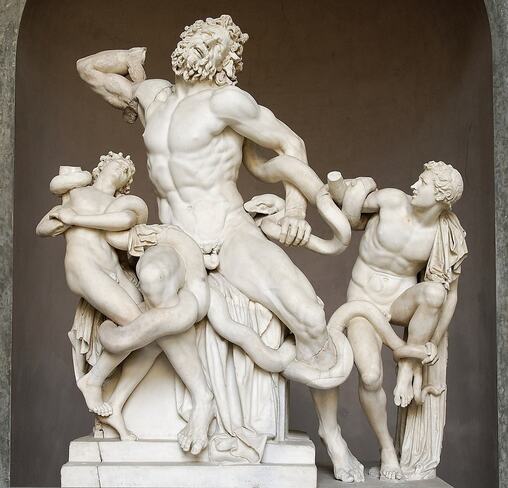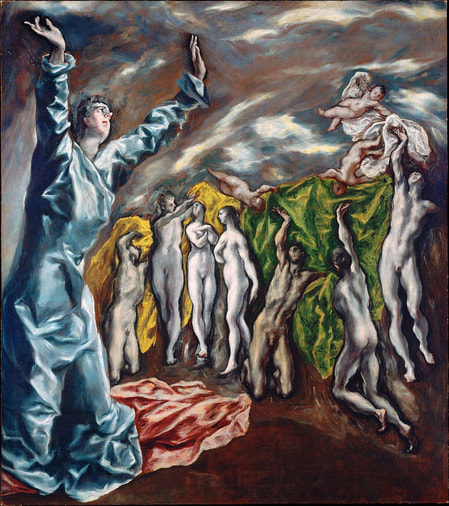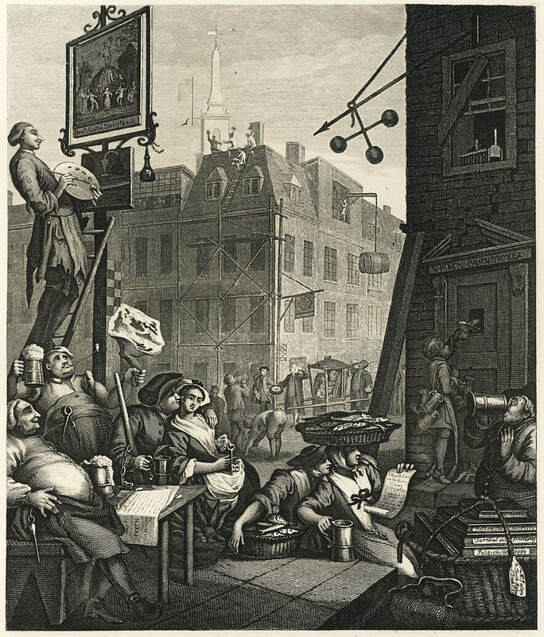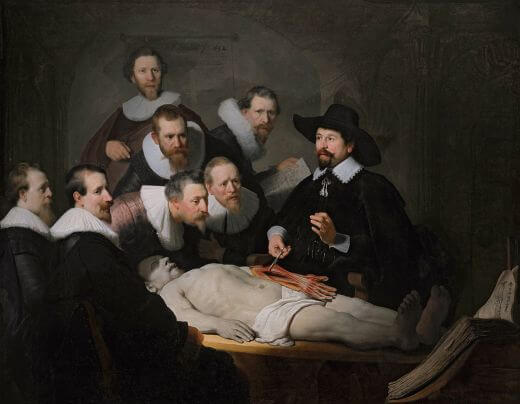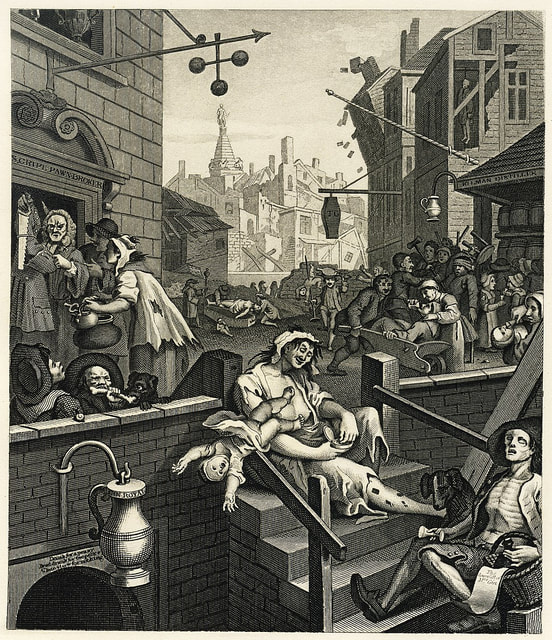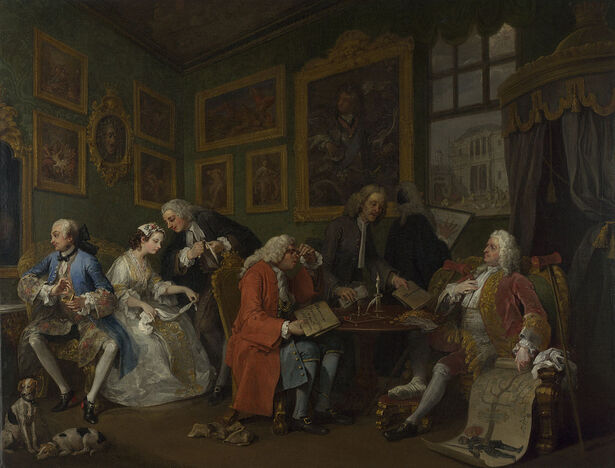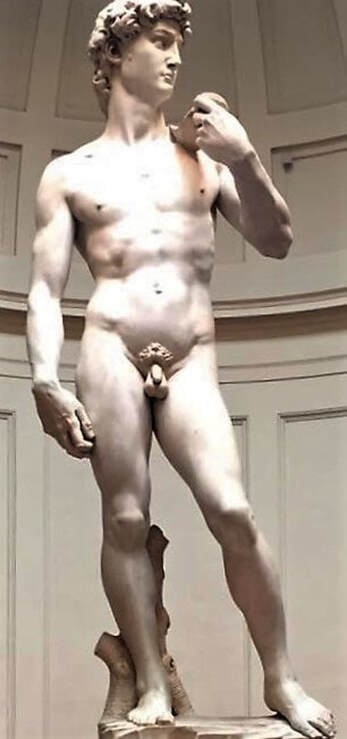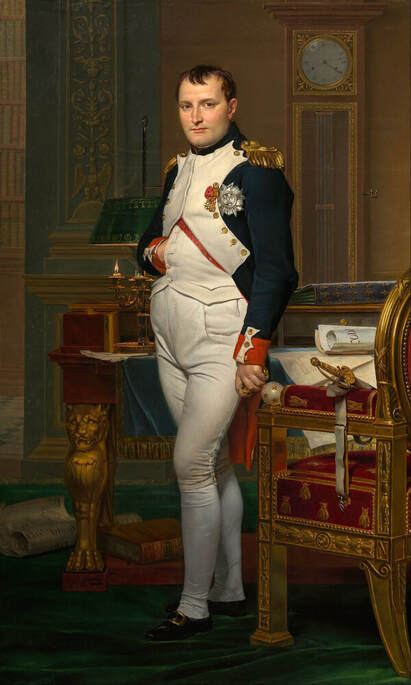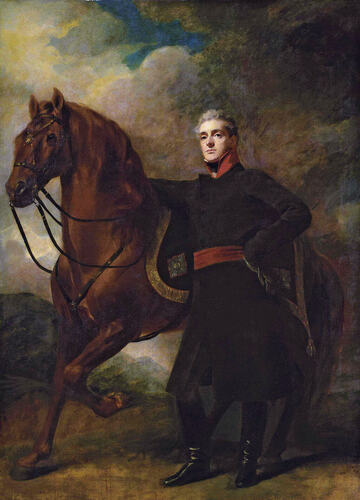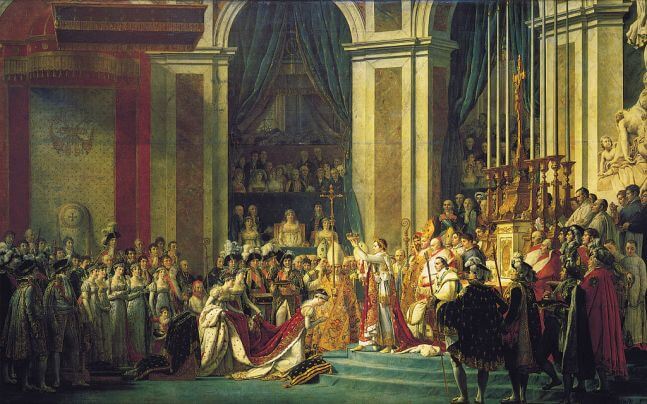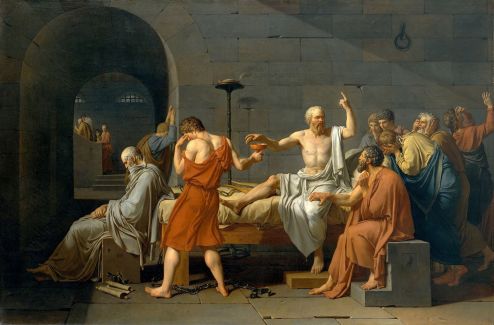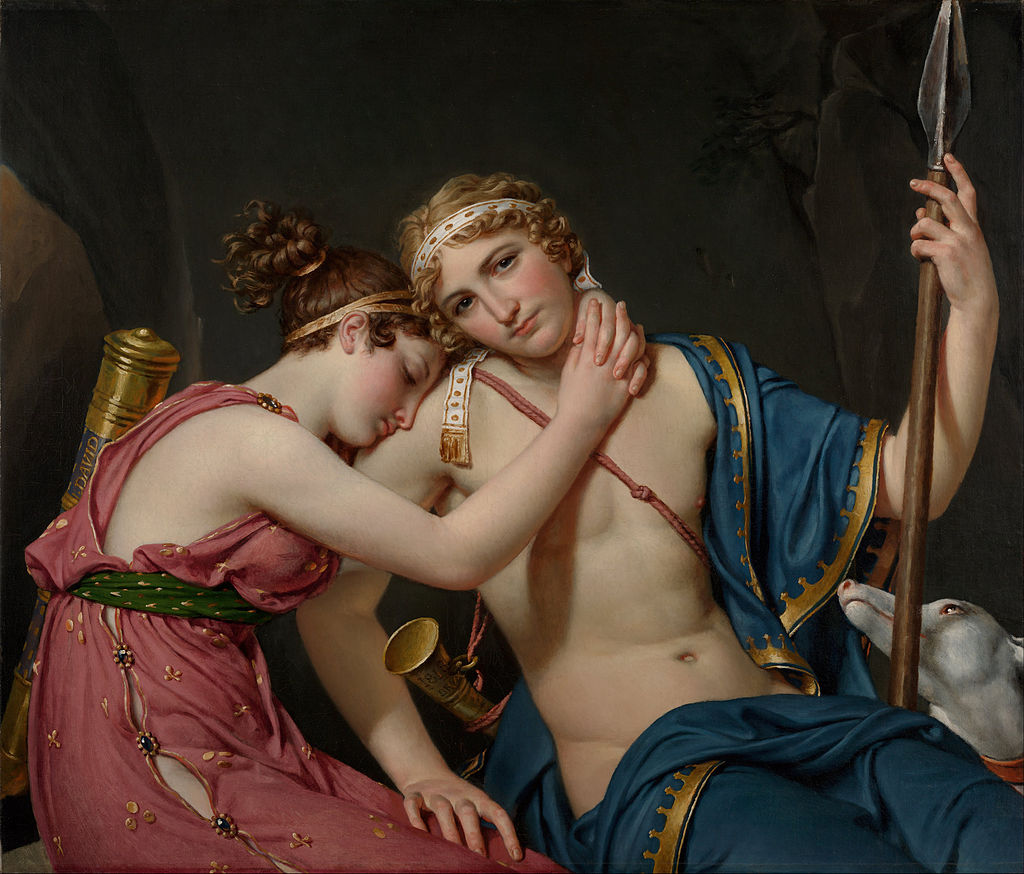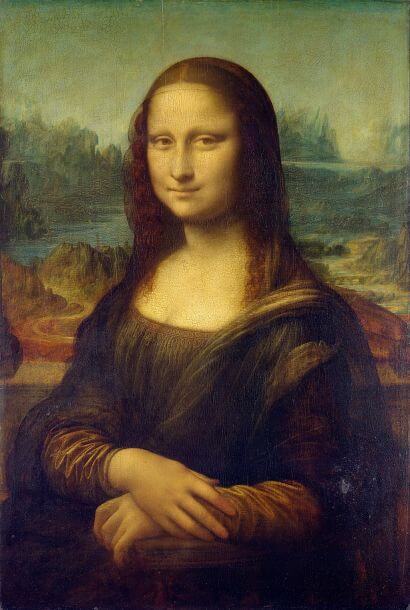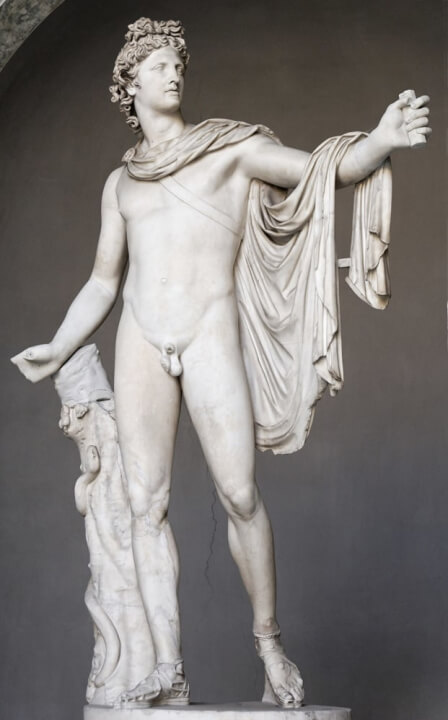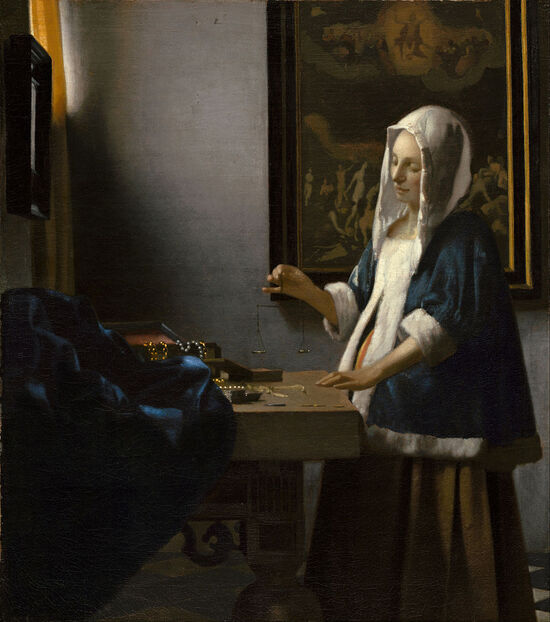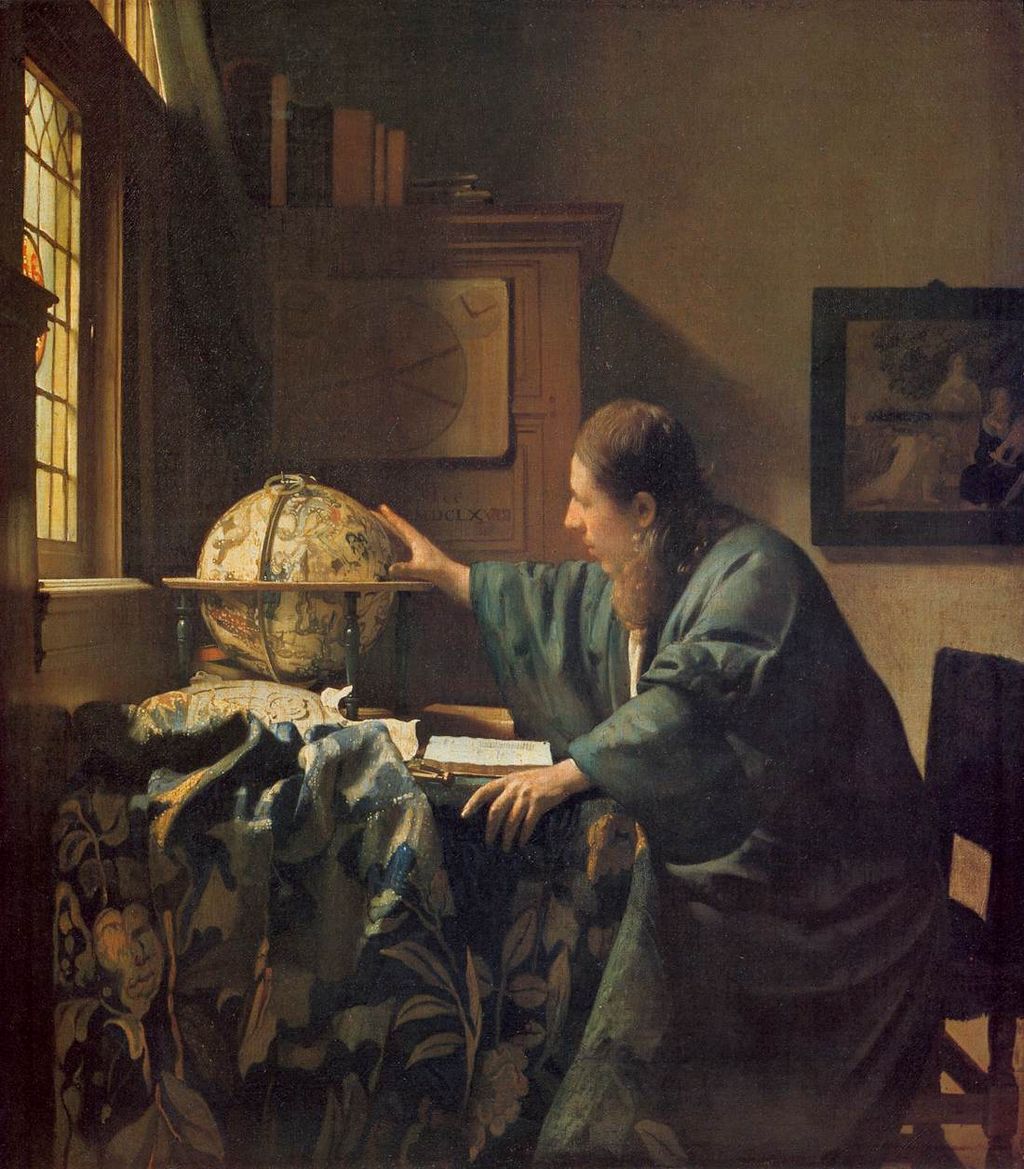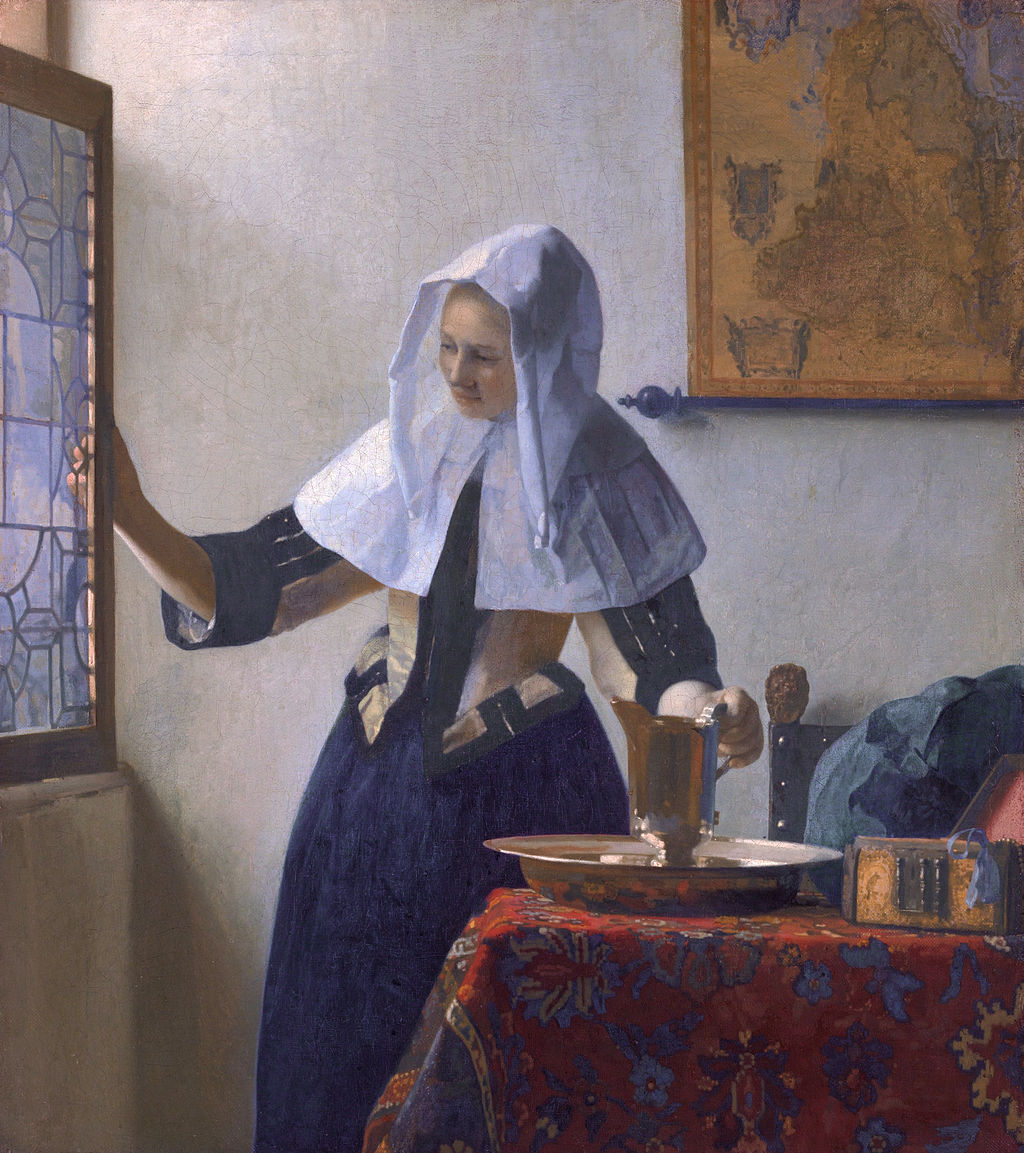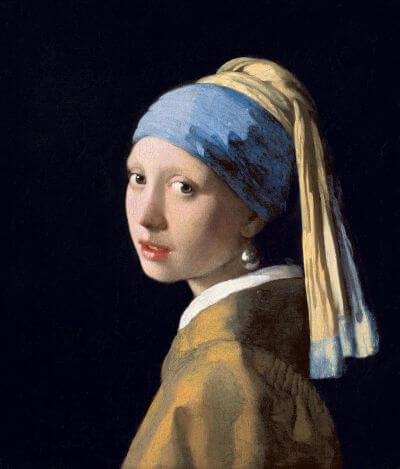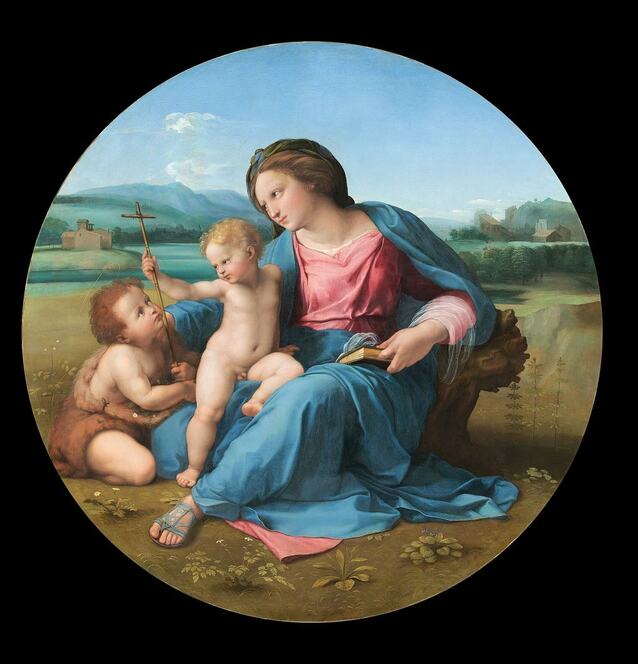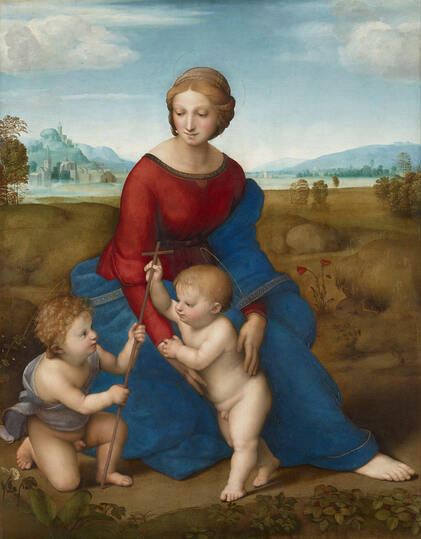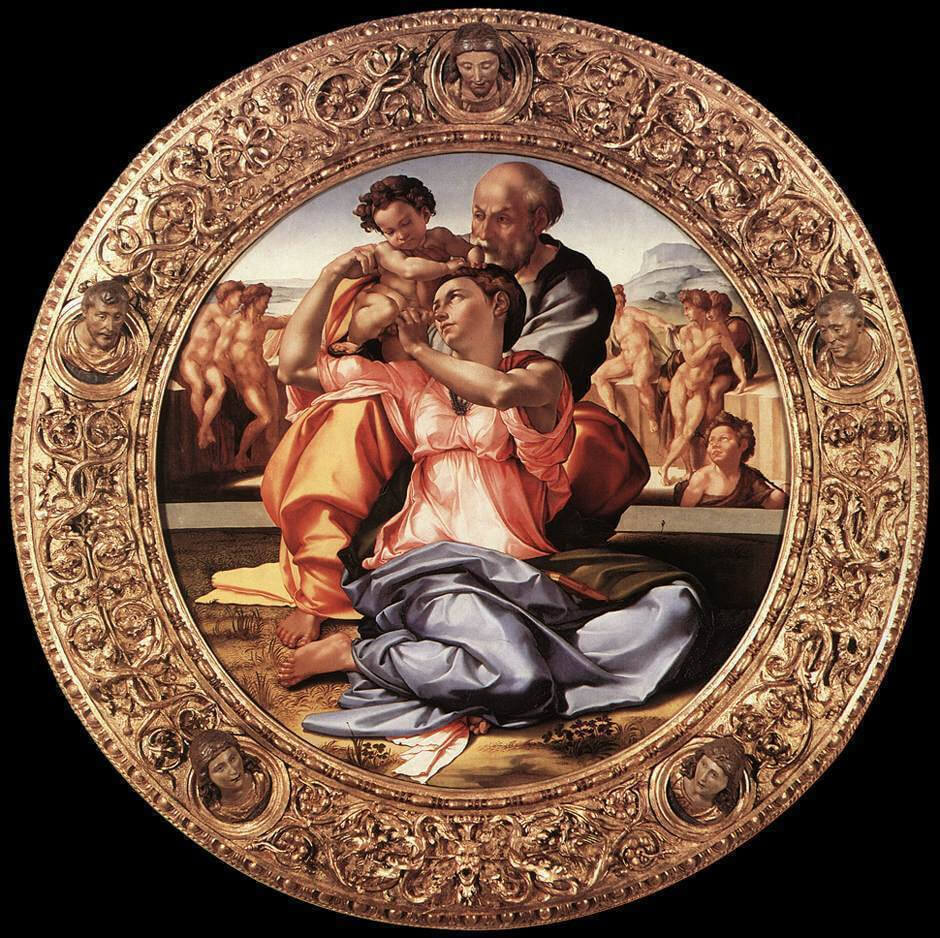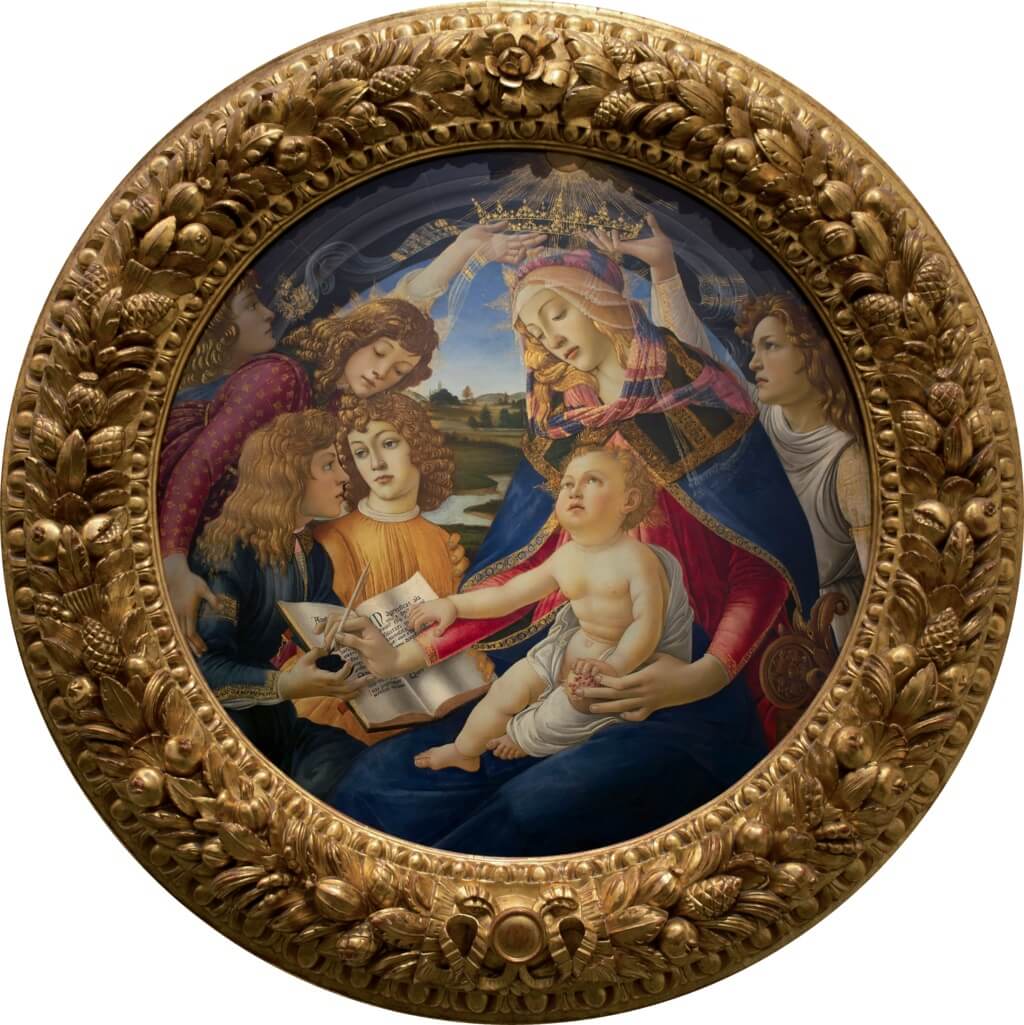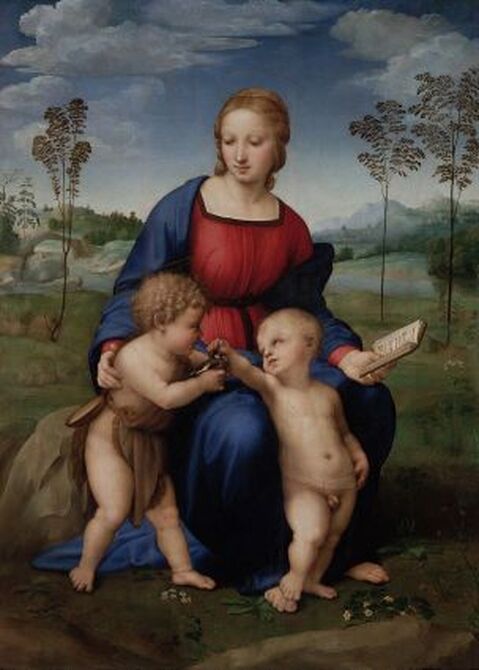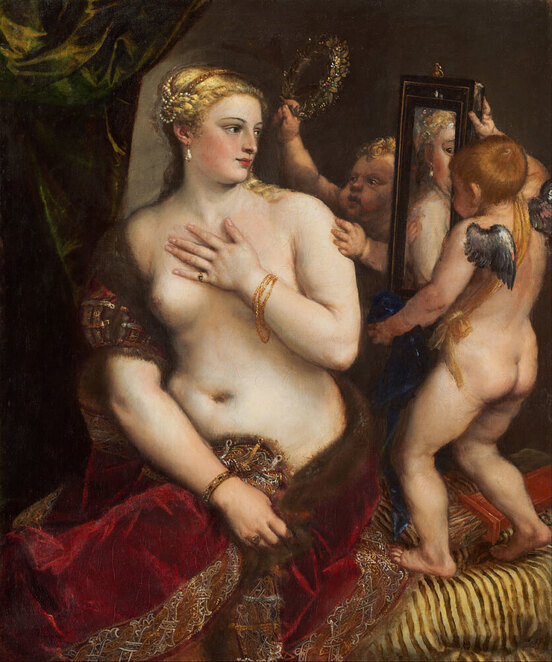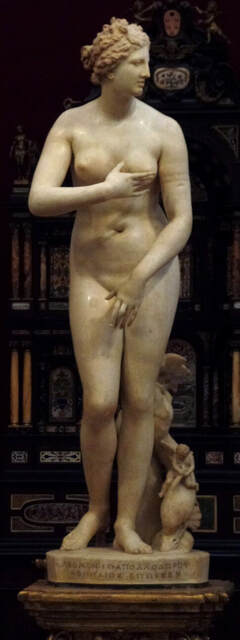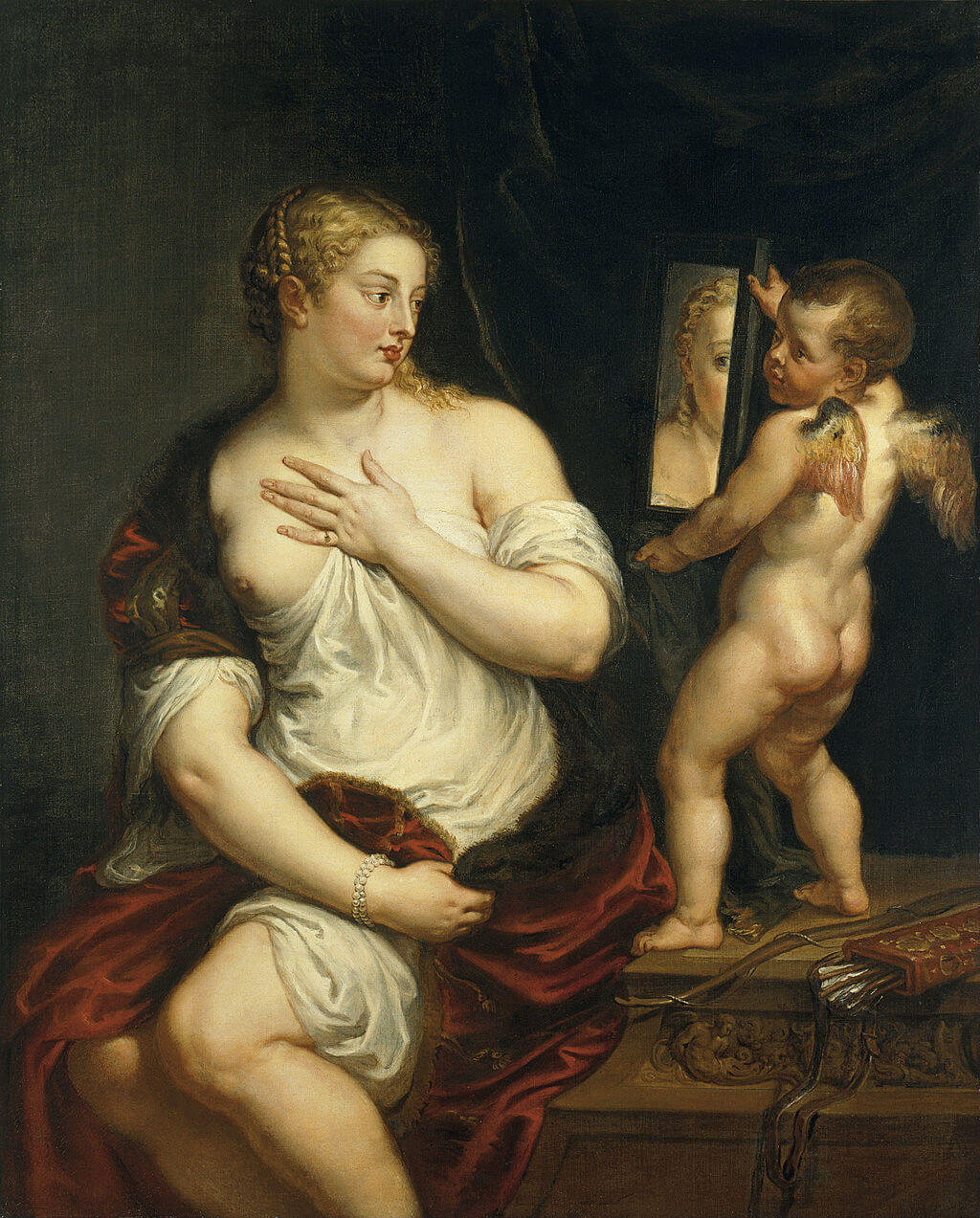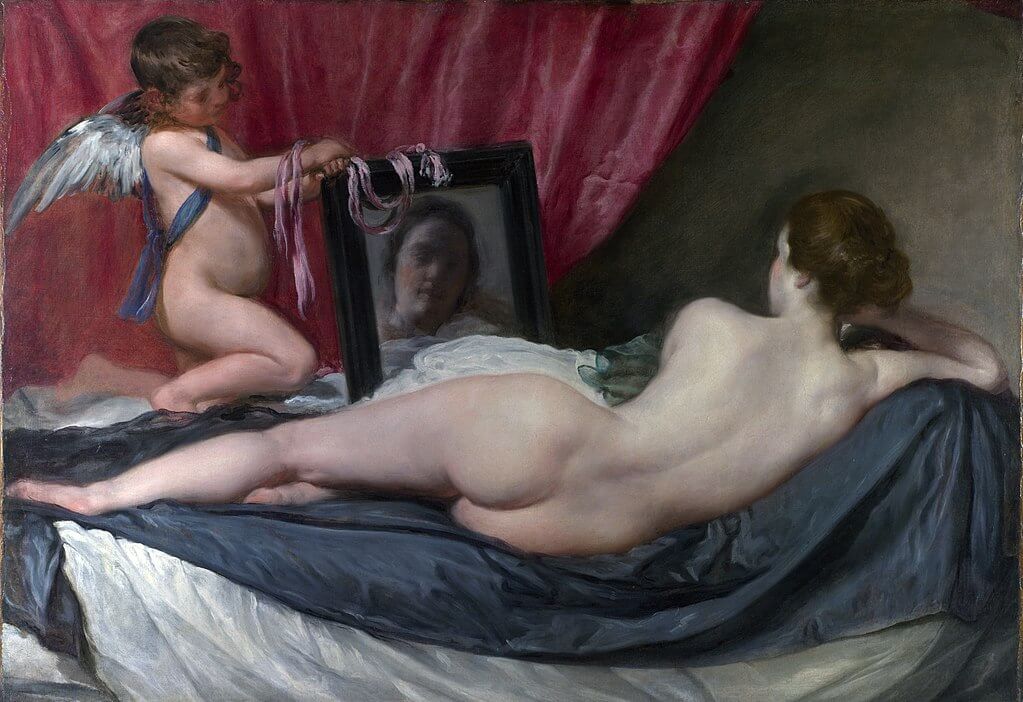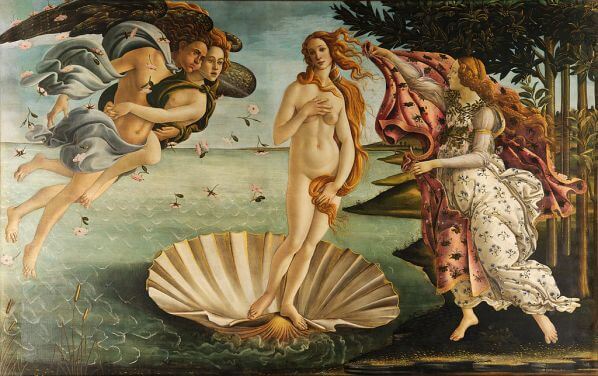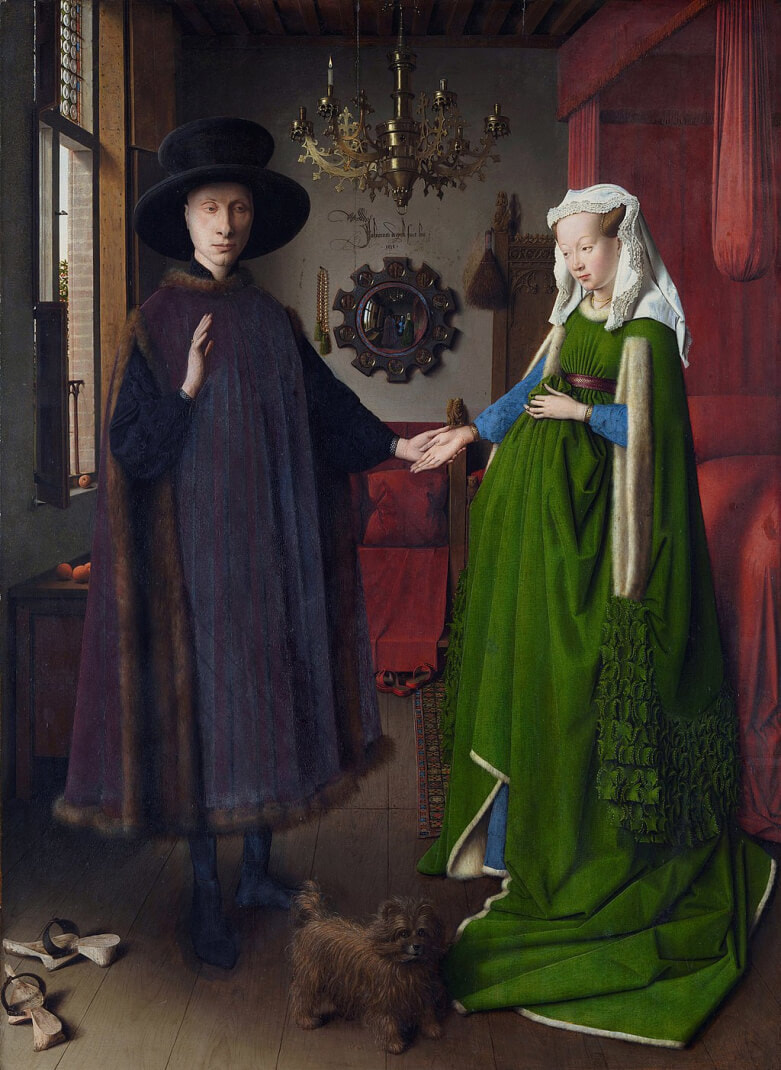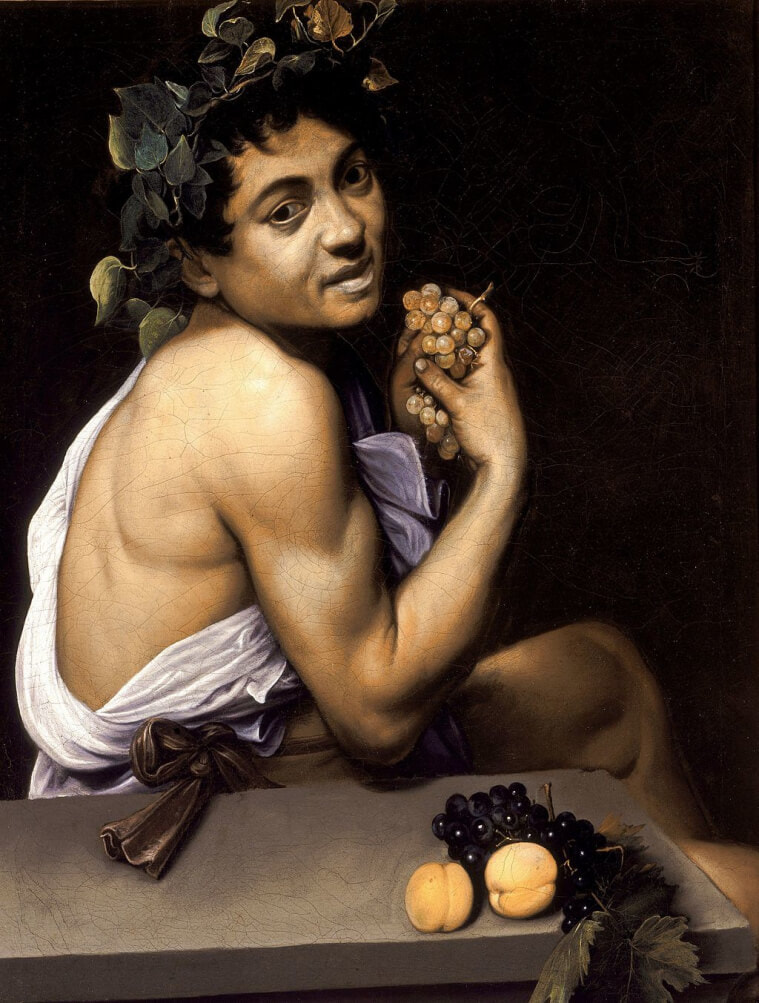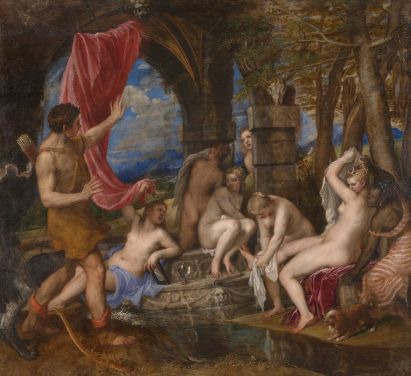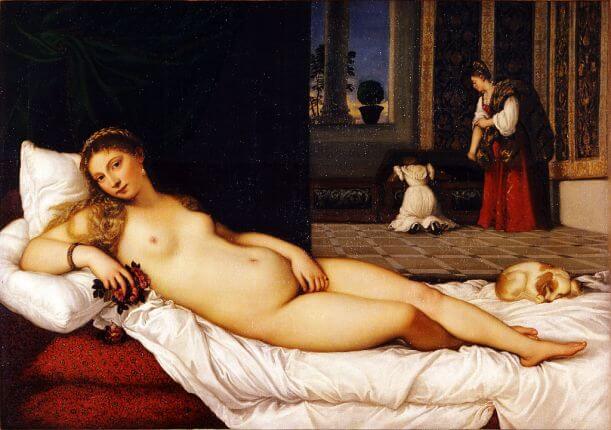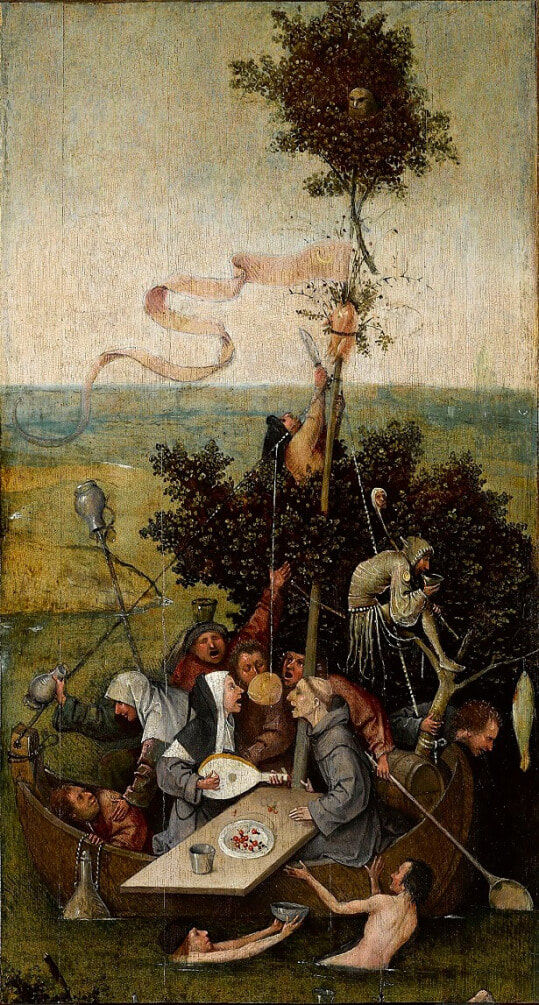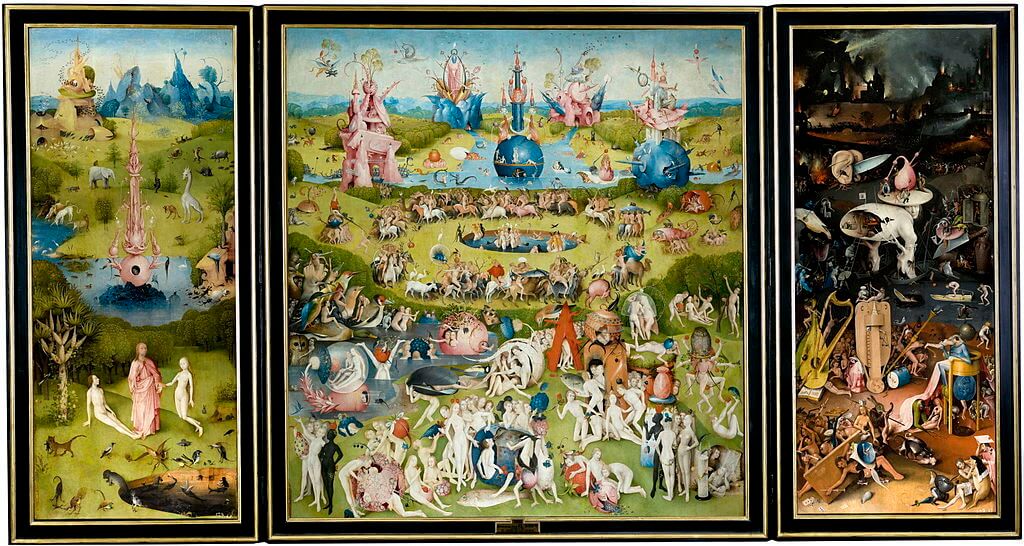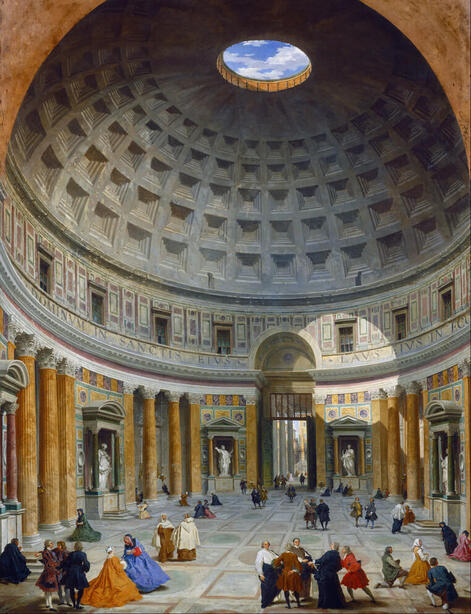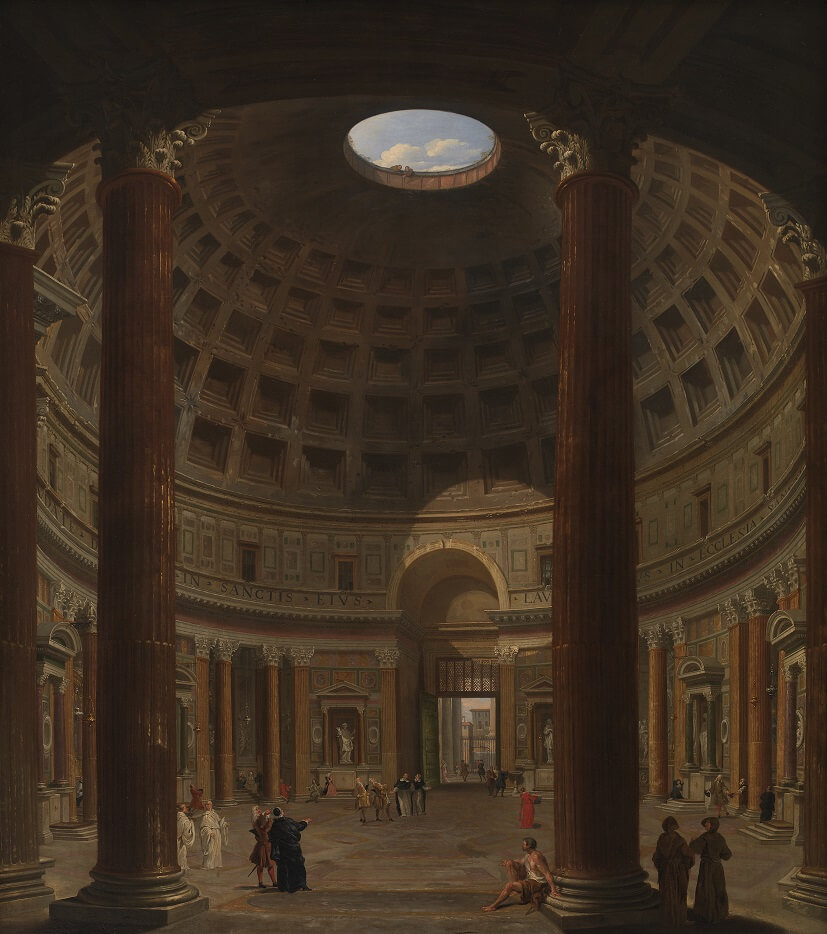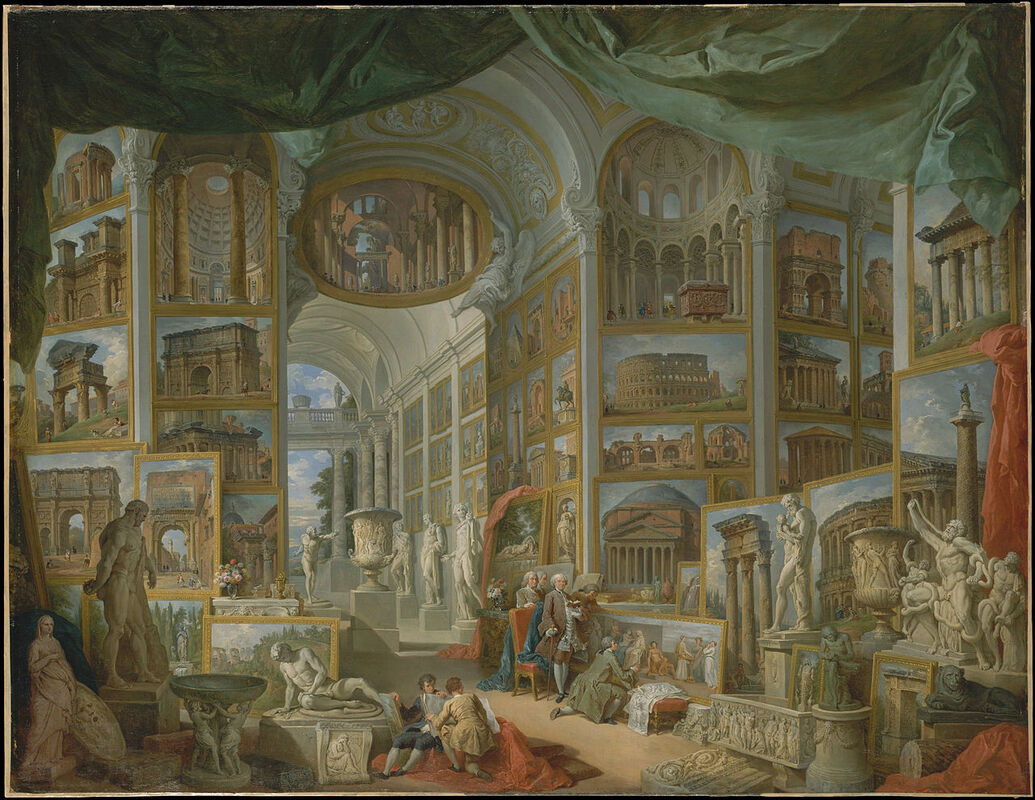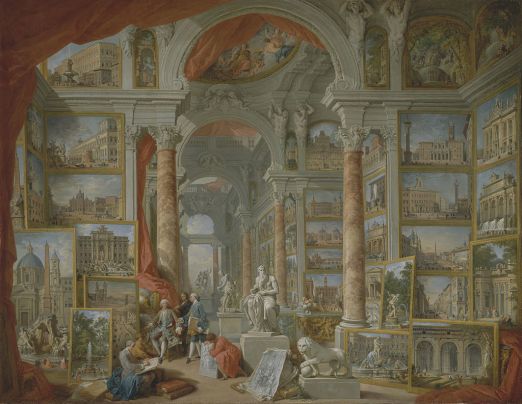|
Where? Gallery 28 of the National Gallery of Art
When? Between 1610 and 1614 What do you see? Laocoön is the bearded man lying down on the dark rocks in the center foreground. He is attacked by a sea serpent (a type of dragon in mythology). He grabs the serpent with both hands, but, nevertheless, the serpent bites him in the head. This serpent has already killed Laocoön’s son who lies to the right of him. On the left side stands the other son of Laocoön. He also struggles to fend off a serpent while the serpent is about to bite him in his abdomen. The three people on the right are unidentified witnesses to the killing of Laocoön and his two sons, though one of them looks away from the scene. They may represent Greek gods who were behind the punishment of Laocoön and his sons, but this is uncertain. The horse behind Laocoön represents the Trojan horse. The horse is on the way to Toledo, the fortified city in the background depicted under a gloomy sky. The entrance gate to the city is directly behind the horse. It is called the Puerta de Bisagra Nueva and still exists. This gate is decorated with a double-headed eagle.
Symbolism: This painting probably contains a deeper meaning. El Greco painted the scene of Laocoön and his sons in front of Toledo, the city where he lived and the former capital of Spain. He painted Toledo instead of Troy, which is the city where the horse is sent according to Greek mythology.
The killing of Laocoön and his sons in this painting takes place on a hill just outside Toledo. This would be the same place where prisoners and people who did not agree with the Catholic Church were executed during that time. The painting of El Greco may have been a protest against these actions. However, there is no substantive evidence to back up this interpretation, so the real meaning of this painting remains speculative. Laocoön and His Sons? According to Greek mythology, Laocoön was a Trojan priest. There are various accounts of his story. Virgil describes the most popular version in the second book of the Aeneid. According to him, when the Greeks left Troy, they left as a gift a very large wooden horse in front of the gates of Troy. Laocoön suspected that this horse was a trick of the Greeks and tried to convince the people of Troy not to accept the gift. To prove that the horse was a trick, he struck the horse with his spear to show that it was hollow. Poseidon and Athena then punished him for his interference and Laocoön and his two sons were attacked and killed by two sea serpents named Porces and Chariboea. The Trojans interpreted this event as a sign that the horse was not a trick and they took the horse into their city walls after which the Greek came out of the horse during the night and defeated the Trojans. A famous statue from antiquity of Laocoön and His Sons is in the Vatican Museums, and a 16th-century copy by Bandinelli is in the Uffizi Museum.
Who is El Greco? Doménikos Theotokópoulos was born in 1541 in Heraklion, Greece, and died in 1614 in Toledo, Spain. He is better known as El Greco, which means ‘the Greek.’ During his twenties and thirties, he spent several years in Italian cities like Venice and Rome, where he got inspiration from artists like Michelangelo and Tintoretto. He eventually moved to Toledo, which is near Madrid. El Greco developed a unique style that is difficult to classify as it was so different from all other painters. He was a Mannerist, he was very expressive, and his work included some fantasy-like elements. His work has inspired many artists over time, including Delacroix, Manet, and Picasso.
Fun fact: El Greco often included nude figures in his paintings. While in the current painting, nudity is somewhat functional as it is based on a mythological story in which people were often depicted nude, he also often included nude figures in his religious paintings. A good example is The Vision of Saint John in the Metropolitan Museum of Art. Interestingly, El Greco grew up in Greece where he was exposed to Byzantine art which contained very little nudity. However, he got inspired by the nude figures painted by Michelangelo and other Renaissance artists during his travels through Italy in the 1560s and 1570s. Interested in a copy for yourself? Poster
0 Comments
Where? Room 1730 of the Main Floor of Tate Britain. Several other museums like the British Museum, Metropolitan Museum of Art, and National Gallery of Art also own this work but do not have it on permanent display.
When? 1751 What do you see? Several groups of well-fed people engage in a variety of activities while drinking mugs of beer. It is the birthday of King George II, and that asks for a celebration. On the left, two corpulent men hold big mugs of beer and one of them holds a huge leg of beef in his left hand. In front of them sits a man holding a beer while sharing a romantic moment with a woman. To the right of them, a couple of women with overflowing baskets of fish pause while enjoying a beer. To their right, a young boy with mugs hanging on a rope slung over his back goes around selling mugs of beer. He stops at the pawnbroker to hand him a beer through the peek hole. The pawn shop is in some state of disrepair as people do not need to pawn off their belonging in this prosperous world where people drink beer. The other buildings are well-maintained, and the church steeple on the top is a sign that people behave morally in this world full of beer. On the bottom right, a portly man enjoys his beer next to a pile of books in a basket. On the left, a painter in ragged clothes blissfully paints a cheery picture of men and women dancing around a mountain of barley. On top of the roofs, construction workers take a break drinking to celebrate while another barrel of beer is being lifted up. Finally, in the center, a wealthy woman in a sedan chair waits as her chairmen have temporarily put her chair down to drink a beer. Laborers around them drink their beer while continuing their work in a timely manner. Backstory: Beer Street takes place during a major movement in 18th-century England: The Age of Enlightenment. This was a philosophical and intellectual movement where people began to ponder major scientific and philosophical thoughts that were captured in paintings such as The Anatomy Lesson of Dr. Nicolaes Tulp by Rembrandt. These ideas were published, and many people learned from them and developed them further. Another idea behind the Age of Enlightenment is that people were trying to apply these new ideas to help other people. Before the Gin Craze, French brandy was popular and fashionable, however, during the Second Hundred Years’ War between France and England, French products were considered unpatriotic and soon lost their following. This led to the Gin Craze where gin and other cheap spirits quickly became popular, and overconsumption of these drinks caused many problems among the lower-class people. William Hogarth’s print was, in essence, a piece of propaganda in favor of the British beer market. Similar to the popularity of Coca-Cola in the United States during modern times, Hogarth makes the argument that beer was not only a remedy to the unregulated gin trade but also a drink that is truly British and helps the country.
Gin Lane: At the time Hogarth created Beer Street, he also created a companion piece called Gin Lane. Most museums that own Beer Street, also have a print from Gin Lane as they were created together. Museums owning Gin Lane include Tate Britain, the British Museum and the National Gallery of Art. However, most museums do not have the prints on permanent display as they are light sensitive. The original copperplates for both works are owned by the Metropolitan Museum of Art.
Gin Lane shows the perilous effects that excessive gin consumption can have on your life. It shows the opposite side of Beer Street where drinking gin leads to chaos, negligence, street brawls, and poverty. The only ones benefiting from the gin craze are the distillery, the pawn shop, and the undertaker.
Who is Hogarth? William Hogarth was born in 1697 in London where he would die 66 years later. Hogarth carefully examined life in 18th-century London and detailed it in etchings and painted satires. He included many symbolic features in his works such that his pieces are not only entertaining but also contain several moral messages.
Hogarth created art both for the upper and lower class. He painted works for his richer clients but also created etchings and engravings of his works that could be mass-produced and sold at a lower price to a larger audience. Among his works is a series of satirical works about the British upper class. The first painting of that series is Marriage A-la-Mode: 1, The Marriage Settlement in the National Gallery in London.
Where? Gallery 56 of the National Gallery of Art
When? 1812 Commissioned by? Alexander Douglas, the Duke of Hamilton, Scotland What do you see? Napoleon poses in his study in the Tuileries Palace. He has worked all night on the Code Napoléon, which is the civil code full of laws for his empire. His work is illustrated by the quill pen on the left of the desk, the papers laying on the right side of the desk, and the scroll with the letters ‘COD,’ which is the Code Napoléon. He gets up from his work to carry his sword and inspect his troops. Napoleon wears the uniform of the foot grenadiers of the Imperial Guard, a group of elite soldiers in the French army. His uniform consists of the colors of the French flag: blue, white, and red. His uniform is decorated with several military awards (including the legion of honour on the left, the highest French military award), gold buttons, and gold epaulets. He has his right hand in his vest, which is a typical pose for Napoleon, and in his left hand, he holds a so-called snuffbox filled with tobacco. Jacques-Louis David included quite some details in this painting that help to tell a story about Napoleon.
Backstory: In 1811, Alexander Hamilton (1767-1852), the Marquis of Hamilton, contacted Jacques-Louis David to paint a portrait of Napoleon. The Duke admired Napoleon for his power and asked David to “transfer onto the canvas the features of the Great Man, and represent him in one of the historic moments that have made him immortal.” For the rest, David was free to decide on the content of the painting, and he could even decide himself on the price that the Duke would have to pay for it. David happily accepted the commission as it was a recognition of his fame outside France, he did not have any major commissions from the French government, and he could earn a lot of money with it. The painting is since 1961 in the National Gallery of Art.
Symbolism: Jacques-Louis David wanted to portray Napoleon as a correct and truthful man. He also wanted to indicate that Napoleon worked very hard for his empire. He purposely included a clock with the time of 4.13am and a candle that was almost finished to indicate that Napoleon was still working deep into the night.
To further emphasize the hard work of Napoleon, David paints him with unkempt hair, wrinkled stockings wrinkled, and the cuffs of his uniform are not all buttoned. Also, the snuffbox in his right hand shows that he used the tobacco to stay awake. The military decorations and the sword on the chair indicate his success as a military leader. The golden bees on the chair on the left symbolize the diligence of Napoleon. Who is Napoleon? Napoléon Bonaparte (1769-1825) was a military political leader in France. He was the leader of the French Revolution in 1789 and became the Emperor of France in 1804. For the next decade, he was the most important statesman in Europe as the French Empire spanned across a large part of Europe, including countries like Italy, Belgium, and The Netherlands. Who is David? Jacques-Louis David (1748-1825) was born in Paris and died in Brussels, Belgium. He is considered the most important Neoclassical painter. David was an admirer of Napoleon and Napoleon was also a big fan of the work of David. In 1804, David became the official court painter of the French empire. He painted multiple works of Napoleon, including the famous The Coronation of Napoleon in the Louvre. Due to his focus on neoclassicism, he also painted a large number of paintings with classical themes, such as The Death of Socrates (1787) in the Metropolitan Museum of Art and The Farewell of Telemachus and Eucharis (1818) in the Getty Museum.
What is the Tuileries Palace? A palace in Paris that was used by many French monarchs until it burned down in 1871. It was built in 1564 and was an enormous palace in the middle of Paris, next to the Louvre.
Fun fact: Napoleon liked art. For example, the Mona Lisa by Leonardo da Vinci hung in his bedroom. He ordered his troops to bring a lot of famous artworks from throughout Europe to France, including the Apollo Belvedere and The Entombment of Christ by Caravaggio in the Vatican Museums, and The Wedding at Cana by Paolo Veronese in the Louvre. He was also a commissioner and collector of contemporary art, though often to promote himself or his empire. Some of the paintings by David, such as the Coronation of Napoleon, are a good example of this self-promotion. Interested in a copy for yourself? Poster.
Where? Gallery 50A of the National Gallery of Art
When? Between 1662 and 1665 Commissioned by? Possibly, Pieter Claesz. van Ruijven, the patron of Vermeer. What do you see? A pregnant woman stands in front of a table while holding a balance. She wears a blue winter jacket with white fur, a white head covering, and a long yellow/orange skirt. Her head is slightly tilted to the left, and she looks down at the balance in her right hand. On top of the table are two jewelry boxes, a pearl necklace, a gold chain, and some coins. The balance in the painting is empty but will be used to weigh the coins on the table. In the left foreground is a large blue cloth. The woman stands in front of a mirror. To the right of the mirror, we can see a yellow curtain that lets in a bit of light. On the wall in the back hangs a painting from The Last Judgment. The floor is covered with black and white tiles. Use of Light: The light that enters on the top left helps us to better identify the colors of the different items in the room. For example, look at the color of the woman’s skirt. If we just look at the color below her waist, it seems yellow-brown, but looking at her belly, it seems that the skirt has a much more cheerful color, more like orange-yellow. Also, look at the color of the tiles. Below the table, the colors and contrasts are vague, but on the right side, in the light, the black and white contrast in the tiles is very clear. Finally, the blue cloth in the bottom left makes it very clear how much effort Vermeer put in accurately incorporating the effects of light into his work. Backstory: This painting has also been referred to as “Woman Weighing Gold” or “Woman Weighing Pearls.” The Last Judgment painting in the background has not been identified yet, but it is probably a mannerist painting from the late 16th or early 17th century. An interesting detail here is that the bottom of that painting on the right side of the woman is lower than on the left side of the woman. Vermeer more often included works of art, like paintings or maps, from other artists in the background of his paintings. For example, The Astronomer in the Louvre has a painting of The Finding of Moses in the background, and in the background of Young Woman with a Water Pitcher in the Metropolitan Museum of Art is a known map of Hapsburg Netherlands.
Symbolism: Vermeer paints a pregnant woman with in the background a painting of The Last Judgment. This painting shows the apocalypse, the time when Jesus comes back to weigh all people on a ‘balance’ of good and bad to decide who goes to Heaven. One the left side of that painting (from our point of view) are the blessed people and on the right side are the damned people. At the same time, the woman is about to weigh some coins to judge their value.
The message of this painting is that one needs to be careful with the earthly pleasures, like jewelry and money, because after you die everyone will be judged by God. The mirror in front of the woman should remind her that she should look in the mirror to evaluate her actions based on the Christian religion. Who is Vermeer? Johannes Vermeer was born in Delft, The Netherlands, in 1632, and died there in 1675. He was the son of an art dealer and a silk weaver. Vermeer took a long time to complete each painting and was very precise. Because of this, he only produced a limited number of paintings. As a result, and in combination with raising his many children, he never got rich. Vermeer is classified as a genre painter (painting simple scenes from everyday life). While less than 40 known paintings are attributed to him, most of his works are of very high quality and very popular nowadays. Some great examples of his work are The Milkmaid in the Rijksmuseum in Amsterdam and Girl with a Pearl Earring in the Mauritshuis in The Hague.
Fun fact: The woman in this painting seems pregnant. This is best visible by looking at her belly, which is accentuated by the colorful part of the skirt. Other signs of her pregnancy are the pale color on her face and some hints of edema (which is a swelling in the legs, feet, and arms). The swelling in her hands is hard to see for the average person, but not for medically trained professionals.
While it is not known who the woman in the painting is, it is not unlikely that she is the wife of Johannes Vermeer, Catharina Bolnes, as they got 15 children together. Interested in a copy for yourself? Poster
Where? Gallery 20 of the National Gallery of Art
When? 1510-1511 Commissioned by? Probably Paolo Giovio, though it could also have been Pope Julius II. What do you see? The beautiful Mary sits on a tree trunk with her son Jesus on her right leg, and Saint John sits next to them on the ground. Mary is dressed in a pink and blue dress, Saint John in a fur robe, and Jesus is naked. Mary is holding a prayer book in her left hand. She looks at the cross that Saint John seems to hand to Jesus. Saint John looks at Jesus and Mary, while Jesus looks at Saint John. Their gazes seem somewhat sad as if they are thinking about what is going to happen to Jesus at the end of his earthly life. Notice the index finger of Jesus that is pointing upwards to God while he receives the cross. Saint John holds some flowers, including anemones and white dandelions. The painting is very peaceful with a calm sky, and the trio is surrounded by flowers, including cyclamen (to the left of Saint John), blue violets (in the left foreground), and lady’s bedstraw (the tall plants on the right). The landscape is probably inspired by the Tiber valley near Rome. Backstory: Raphael painted this work while he was in Rome, at the same time that he worked on the famous Raphael Rooms in the Vatican Museums. It is most likely that this painting was commissioned by Paolo Giovio and gifted to the church of the Olivetani in Nocera dei Pagani when he was appointed a bishop there. However, some people also argue that it could have been commissioned by Pope Julius II who Raphael was working for in 1510. The name of the painting, Alba Madonna, is given because the painting was owned by the aristocratic Spanish House of Alba during the 18th century. As Raphael painted many Madonna-themed paintings, this name differentiates it from the others.
Tondos? This painting of Raphael is a so-called tondo. A tondo is used to refer to a circular painting over two feet (60 cm) in diameter. The word ‘tondo’ is derived from the Italian word ‘rotondo’, which means round. A tondo helps the viewer to focus on the center of the painting. The circular shape is also perceived to be an ideal and infinite shape. These are the reasons that the tondo was often used for Madonnas as the focus of those paintings had to be on Mary and Jesus. You can also see in this painting that the composition of Mary, Jesus, and Saint John is quite circular.
The tondo format was mainly popular in the 15th and 16th century and has been used by painters such as Botticelli, Michelangelo, and Raphael. One of the most well-known tondos is the Doni Tondo by Michelangelo in the Uffizi Museum in Florence. Another example is the Madonna of the Magnificat by Botticelli which is also in the Uffizi.
Fun fact: Raphael has created many religious paintings during his career, and especially many Madonnas. However, Raphael did not always live like a religious person. In fact, rumors are that he had many affairs with women while he was in Rome. In 1514 he got engaged to Maria Bibbiena, but he never married her.
Vasari also writes in his book that Raphael died (which may have been on his birthday) after a night of excessive sex. After the wild night he got sick but did not want to tell the doctors the cause of it. As a result, they did not provide him with the right treatment and he died.
Where? Gallery 23 of the National Gallery of Art
When? 1555 Commissioned by? Unknown What do you see? Venus looking in the mirror with two Cupids. Venus wears some makeup, visible in her rosy cheeks and red lips. We see the upper part of Venus’ body. She covers one of her breasts with her left arm. The lower part of her body is covered by a thick velvet drapery, decorated with beautiful gold and silver embroidery. The drapery contrast nicely with her pale skin. She wears earrings, two bracelets, and two rings. Venus studies herself in the mirror. One Cupid holds to mirror in front of her while the other wants to put a garland on her head as a symbol of love. Background: Titian painted two quite similar versions of Venus with a Mirror, but one of them is considered lost. The current version remained in the studio of Titian until his death and was sold in 1581 by his son Pompino to the Barbagio family. Possibly, Titian did not finish the painting completely which would explain why the work was still in his studio. In this case, someone else, maybe the son of Titian, has completed the last parts of the painting before selling it.
Who is Venus? The Roman goddess of love, beauty, and desire. The myths about her are based on the Greek goddess Aphrodite. She was very appealing to the Roman people as she could provide beauty, military victories, prosperity, and a good sex life. For these reasons, she is the most popular goddess in art.
Venus has inspired many artists, including Botticelli, Canova, David, Ingres, Raphael, Rubens, Velázquez, and Veronese. The most famous painting on Venus is probably The Birth of Venus by Sandro Botticelli which shows how Venus was born from the sea as a mature and sexual woman.
Why a mirror? The presence of a mirror is a great trick that painters can apply in their work. There was often debate between sculptors and painters, whereby the sculptors claimed that only they could show a person from all different angles. A mirror was a way for painters to mitigate this problem as they could show other sides of a person in a natural way.
A well-known painting in which the mirror plays an important role is The Arnolfini Portrait by Van Eyck in the National Gallery. Mirrors have also frequently been used by painters to paint self-portraits. Caravaggio was a frequent user of the mirror. Young Sick Bacchus in the Galleria Borghese is one of several paintings for which Caravaggio used a mirror.
Who is Titian? Tiziano Vecelli(o) was born around 1489 near Venice, Italy, and died there in 1576. He was the most influential member of the Venetian School of Painting. Other well-known members are Jacopo Tintoretto and Paolo Veronese. The Venetian painters are known for their use of a wide variety of colors which were available to them because Venice was an important port with lots of import from the Middle and Far East.
Titian was an expert in all sorts of paintings, including mythological and religious works, landscapes, and portraits. However, he is probably best known for his female nudes. His works include Diana and Actaeon in the National Gallery in London and the Venus of Urbino in the Uffizi Museum.
Fun fact: While Titian is considered to be one of the best and most versatile painters from the 16th century, he also had his limitations. Michelangelo, perhaps the most famous painter ever, criticized the limited drawing skills of Titian. In this painting, we can see some examples of that.
Interested in a copy for yourself? Poster or canvas
Where? Gallery 41 of the National Gallery of Art
When? Between 1485 and 1516 What do you see? The final moments of the life of a miser, who is a stingy person collecting a lot of wealth. The painting consists of three scenes.
Symbolism: The moral message of this painting is a warning against greed. Humans often face the tradeoff between earthly wealth, also referred to as avarice, and faith. The items in the trunk (the dagger, metal cups, and the golden weight) represent various items that people pawned when they were in need of money. These items were typically pawned against a high interest rate, which was against the laws of the Church.
Who is Bosch? Hieronymus Bosch, also known as Jhernoymus or Jeroen Bosch, was born around 1450 under the name Jheronymus van Aken in ‘s-Hertogenbosch, in the south of The Netherlands. He also died there in 1516. He was an innovative painter who found novel ways to depict existing themes. He is especially known for his satiric paintings. Not too much is known about his life and therefore there is also a lot of debate whether Bosch really created certain paintings and when he created them. However, his innovative works have had a big influence on future painters, such as Pieter Bruegel the Elder and Salvador Dalí. His most famous work is the Garden of Earthly Delights in the Prado Museum in Madrid.
Fun fact: Based on infrared pictures, various adjustments to this painting by Bosch have been discovered. For example, in the underdrawing, the miser initially held a covered goblet that he seemed to offer to the figure of Death near the door. This would be an obvious clue that the miser wanted to offer Death some earthly wealth to change his decision. In the final version of the painting, the miser is looking at Death while pointing with his right hand to the money bag that is held by the devil. This clue is a bit more ambiguous but still suggests that the miser wants to offer money to Death. Another example is that the underdrawing shows the inclusion of a flask with drinking glasses and a rosary in the scene in the foreground.
Interested in a copy for yourself? Poster.
Where? Gallery 30 of the National Gallery of Art
When? About 1734 Commissioned by? Unknown What do you see? Around 50 people are inside the Pantheon. They are engaged in different activities like admiring the architecture, talking, and praying. They look small compared to the size of the building. Most people stand or kneel in the open space in the middle. Enormous Corinthian columns and statues surround this space. In the middle background is the entrance to the Pantheon and we can identify the Egyptian obelisk in the Piazza della Rotonda in front of the Pantheon. The dome is decorated with sunken square panels (called a coffered ceiling). The light enters through the opening in the dome. You can see the sunlight just to the right of the entrance to the Pantheon. The floor is decorated with squares and circles which are also used to decorate the walls. Backstory: The view in this painting is not entirely realistic. While Panini accurately painted the Pantheon, the painting shows more than is possible from a single place in the Pantheon. Since 609 AD, the Pantheon is a Christian church and quite some modifications to the Pantheon have been made over time. As a result, the view that Panini painted is not the same as what you see today when visiting the Pantheon. For example, the bottom of the dome contains some inscriptions.
Different versions of this painting: Panini created several other versions of this painting. At least eight versions are known of which four are on public display and the others are in private collections. All versions are somewhat different from each other. The versions on public display can be divided into two types.
History of the Pantheon? The Pantheon was built between 113 and 126 AD, during the reign of the Roman Emperor Hadrian. It was built on the spot of a burnt-down Roman temple built by Agrippa between 29 and 19 BC. Pantheon literally means ‘all gods’ and was dedicated to every Roman God. However, in 609 AD the Pantheon became a Catholic church. The Pantheon is also called Church of St. Mary and the Martyrs and every week at least two masses are held inside.
The height of the dome and the diameter of the dome are the same, 142 feet (43 meters). The diameter of the opening on the top is 27 feet (8 meters). Quite some famous people, including kings and artists, are buried in the Pantheon, including Raphael. Who is Panini? Giovanni Paolo Panini was born in 1691 in Piacenza, Italy, and died in Rome in 1765. He was both a painter and an architect, which explains why he liked to paint buildings. He was popular among tourists for his paintings with views of Rome and some of the most impressive buildings in Rome. As photography did not exist yet in the 17th century, tourists asked Panini to draw some of the major sights as a memory to their trip. Two of his most famous paintings are Ancient Rome (with versions in the Louvre, Metropolitan Museum of Art, and the Staatsgalerie in Stuttgart) and Modern Rome (with versions in the Louvre, Metropolitan Museum of Art, and the Museum of Fine Arts).
Fun fact: The Pantheon has served as the inspiration for the Rotunda of the West Building of the National Gallery of Art. The rotunda is in the center of the main floor of the West Building and is the major entrance to the museum. The dome is similar, including the sunken square panels, and there is also an opening on the top to let the light in. The main difference, though, is that this opening is covered by glass such that the rain or snow cannot enter the museum.
Interested in a copy for yourself? Poster or canvas. |
Categories
All
|
- Home
- Blog
-
Museums
- Alte Pinakothek
- Art Institute of Chicago
- Baltimore Museum of Art
- Barber Institute of Fine Arts
- Bargello
- Barnes Foundation
- British Museum
- Church of Sant’Anastasia
- Cleveland Museum of Art
- Courtauld Institute of Art
- Detroit Institute of Arts
- Frans Hals Museum
- Galleria Borghese
- Gallerie dell'Accademia
- Getty Museum
- Guggenheim
- Hermitage Museum
- Kunsthistorisches Museum
- Kunstmuseum Basel
- Legion of Honor Museum
- Louvre
- Mauritshuis
- Metropolitan Museum of Art
- Musee d’Orsay
- Museum of Fine Arts in Boston
- Museum of Modern Art
- National Gallery in London
- National Gallery of Art
- National Museum in Poznań
- Norton Simon Museum
- Ny Carlsberg Glyptotek
- Palace of Versailles
- Palazzo Pitti
- Palazzo Vecchio
- Petit Palais
- Philadelphia Museum of Art
- Prado
- Pushkin Museum
- Ravenna Art Museum
- Rijksmuseum
- San Diego Museum of Art
- Santa Maria delle Grazie
- St. Peter's Basilica
- Städel Museum
- Statens Museum for Kunst
- Tate Britain
- Tate Modern
- Timken Museum of Art
- Uffizi
- Vatican Museums
- Wallace Collection
-
Artists
- Altdorfer
- Anguissola
- Berlin Painter
- Bosch
- Botticelli
- Boucher
- Bronzino
- Bruegel the Elder
- Brunelleschi
- Cabanel
- Caillebotte
- Canova
- Caravaggio
- Carpeaux
- Cezanne
- Cimabue
- David
- Degas
- Delacroix
- De Maria
- Donatello
- El Greco
- Fontana
- Fra Angelico
- Fragonard
- Gauguin
- Gentileschi
- Gericault
- Gonzalez-Torres
- Goya
- Hals
- Hogarth
- Hokusai
- Ingres
- Leonardo da Vinci
- Lippi, Filippo
- Longhi, Barbara
- Lorrain
- Makovsky
- Manet
- Massys
- Matisse
- Michelangelo
- Mochi
- Modigliani
- Monet
- Panini
- Parmigianino
- Perugino
- Picasso
- Pisanello
- Raphael
- Rembrandt
- Renoir
- Reynolds
- Rivera
- Rodin
- Rubens
- Scultori
- Seurat
- Steen
- Tintoretto
- Titian
- Toulouse-Lautrec
- Turner
- Uccello
- Van der Weyden
- Van Dyck
- Van Eyck
- Van Gogh
- Van Hemessen
- Vasari
- Velazquez
- Vermeer
- Veronese
- Vigée Le Brun
-
Locations
- Books
- About Us

